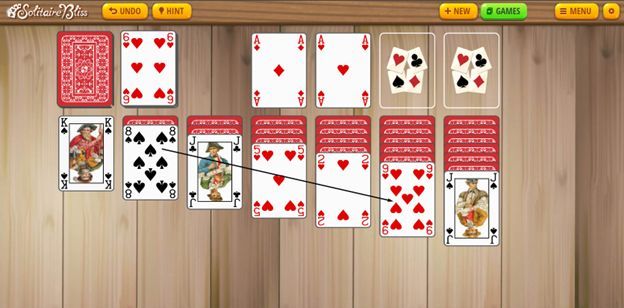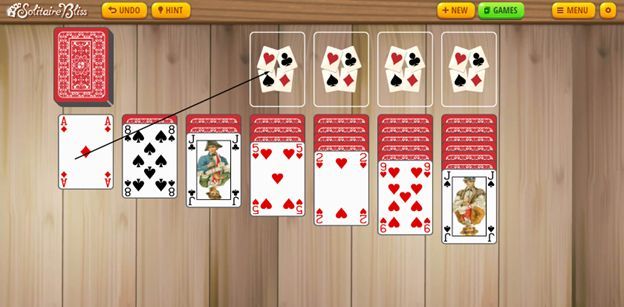Monster Hunter: World, How to Unlock More Botanical Research Slots
Get 2 more slots for your farm in Monster Hunter: World
by Grayshadow on Feb 05, 2018
Solitaire has an intriguing history. While its exact origins remain uncertain, its popularity has spread across generations and continents, captivating players with its engaging gameplay and strategic challenges.
The earliest known version of the game can be traced back to the late 18th century. The game was primarily played in Europe and was known by different names, including "Patience" in Britain and "Success" in France. It was during the French Revolution that Solitaire gained significant attention, as it became a favorite pastime of Marie Antoinette during her imprisonment.
In the early 19th century it made its way into America, where it quickly gained popularity among the frontier population and became widely known as Klondike. The game was especially popular during the California Gold Rush in the late 1840s. Miners would spend hours playing the card game in their cabins, seeking entertainment and solace amidst the harsh conditions of the goldfields.

Microsoft’s first version of Solitaire card game on Windows
In the 1980s, with the rise of personal computers, it made a remarkable transition into the digital world. Microsoft included Solitaire in as a pre-installed game in its Windows operating system, introducing it to millions of computer users worldwide. The accessibility and addictive nature of the digital version contributed to its widespread popularity, making it one of the most recognizable computer games of all time.
Today, it has found a new home in the realm of online websites and mobile devices, as playing Solitaire has never been easier. With the advent of smartphones and tablets, it’s no wonder patience has become a staple game for casual gamers on the go. Countless mobile apps and online platforms offer various versions, keeping the spirit of the game alive and well in the modern era.
The enduring appeal lies in its simplicity, accessibility, and the inherent satisfaction of successfully completing a game. Its ability to provide a sense of relaxation, mental stimulation, and challenge has made it a beloved pastime for people of all ages, transcending borders and cultures.
Whether played with physical cards or through digital platforms, Solitaire continues to captivate players, offering a welcome escape from the hustle and bustle of everyday life. Its fascinating history and enduring popularity serve as a testament to the timeless nature of this captivating game.
Before we jump into the strategy, let’s go over the principles of the game
The Basic Rules of Solitaire
In order to begin playing the game, you are going to need a standard deck of 52 cards. The goal of the game is to build four foundation piles, each starting with an Ace and ending with a King, in each of the four suits (hearts, diamonds, clubs, and spades).
Here is how you should start:
Set Up:
Shuffle the deck of cards thoroughly.
Deal a tableau, consisting of seven piles, from left to right. The first pile contains one card, the second has two cards (one face-up and one face-down), the third has three cards (one face-up and two face-down), and so on.
Place the remaining cards face-down in the stockpile.

This is how the tableau is supposed to look at the start of the game
Gameplay:
Flip the top card of the stock pile face-up to start the waste pile.
Move cards from the tableau and waste pile to the foundation piles in ascending order, alternating colors. For example, place a red 2 on top of a red Ace.

Build up the formation piles with the corresponding suits
You can build on the tableau by placing cards in descending order and alternating colors. For instance, a black 8 can be placed on a red 9.

Progress the game by moving 8 to 9 in order to open more piles
Cards from the waste pile or tableau can be moved to other tableau piles or onto the foundation piles.

The Ace goes into the foundation pile
If a tableau pile becomes empty, only a King (or a sequence starting with a King) can be placed on it.

Drag a King to an open pile
You can turn over face-down cards in the tableau pile once all face-up cards on top of them are removed.
Stockpile and Recycling:
If you can't make any moves, you can turn over cards from the stockpile to the waste pile, one at a time.
Once the stockpile is empty, you can turn over the waste pile and use it as the new stockpile. However, this can only be done once in a game.
Winning:
The game is won when all cards are moved to the foundation piles in the correct order.
Strategy
While Solitaire may initially appear to be a game of luck, there are several proven strategies that can help you improve your chances of achieving a winning streak. By employing these strategies and incorporating them into your gameplay, you can enhance your decision-making and increase your odds of success. Here are some key tips and tricks to keep in mind:
1. Plan Ahead:
Before making any moves, take a moment to analyze the tableau and identify potential moves that will help you uncover face-down cards or build up foundation piles. Look for opportunities to create empty tableau piles, as they can be used strategically to free valuable cards. Visualize the possible outcomes of each move and try to make choices that set you up for future success.
2. Priority Moves:
Always prioritize moving cards to the foundation piles. This should be your primary goal throughout the game. Building foundation piles early not only helps you free up tableau space but also increases your options for future moves. Whenever possible, focus on moving Aces and cards of the same suit onto the foundation piles to start building the sequences.
3. Uncovering Face-down Cards:
Whenever possible, prioritize moves that uncover face-down cards in the tableau. These cards can open up new possibilities and provide you with more options for building sequences and moving cards to the foundation piles. Building on uncovered cards allows you to access the face-down cards beneath them, giving you greater control over the game.
4. Empty Piles and Kings:
Creating empty tableau piles is crucial for efficient gameplay. Whenever you have the opportunity to move cards around and create an empty pile, do so strategically. Empty piles can serve as temporary storage spaces for cards that are blocking other important moves.
Additionally, remember that only Kings (or sequences starting with a King) can be placed on empty tableau piles, so plan your moves accordingly.
5. Long Runs and Exposing Hidden Cards:
Building long runs within the tableau can be advantageous. Look for opportunities to create sequences of descending cards of alternating colors. Not only does this allow you to move larger groups of cards at once, but it also helps expose hidden cards in the tableau. Exposing hidden cards provides more flexibility and choices for future moves.
6. Stockpile Management:
The stockpile can be a valuable resource when used wisely. Avoid flipping cards from the stockpile to the waste pile without careful consideration. Instead, evaluate the potential benefits of turning over a new card. If turning over a new card will grant you access to previously hidden cards or allow you to make strategic moves, it is worth doing so.
However, be cautious and avoid emptying the stockpile too quickly, as you can only recycle the waste pile once in a game.
7. Patience and Persistence:
Solitaire requires patience and a calm approach. Don't be discouraged by setbacks or difficult situations. Sometimes, you may encounter games that seem unwinnable at first glance. Don’t give up, as with careful analysis and strategic moves, you might find hidden opportunities to turn the game around.
Remember, practice makes perfect, so keep playing and refining your strategies.
In Closing
As we wrap up this article on Solitaire’s strategies, it's clear that there is more to this timeless game than meets the eye.
Take your time, analyze the cards, and strategize your moves. Don't be afraid to experiment with different approaches and adapt your tactics as you go along. The more you practice, the better you'll become at recognizing patterns and making informed decisions. It's important to maintain a calm and focused mindset throughout the game. Avoid rushing through the piles or making impulsive moves that could hinder your progress.
Lastly, never forget that Solitaire is ultimately a game meant to be enjoyed. Whether you're playing to relax, challenge yourself, or pass the time, embrace the process and savor each victory, no matter how small. Celebrate your achievements and learn from your setbacks to continuously improve your Solitaire skills.
Best of luck, and may every move bring you closer to triumph!
Contributor, NoobFeed
Latest Articles
No Data.

